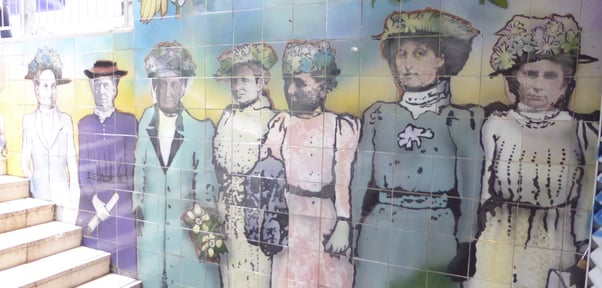Geothermals, giant trees, and guided tours
Our experiences in Rotorua and Auckland before sending off my folks home.
COUNTRIES
After a delightful climb up and down Mount Doom (all 10 fingers still intact) we headed on to the town of Rotorua. Rotorua is known for both its geothermal activity and Maori culture. And let me tell you, Rotorua gives Yellowstone a run for its money here for witnessing geothermal glories. There are thousands of geysers and bubbling mud pools, and hot thermal springs. What felt especially unique, was how the town is built up right around them; a surprisingly large and busy town by the New Zealand standards we'd grown used to. Our holiday park (think nice RV park with added cabins) had hot little streams running all its borders and hot tubs heated by the groundwater beneath. We walked in an urban park that had a pond that steamed so much in the cool air you couldn't see where you were walking, bubbling mud pools mid-path, and free foot-soaking baths with lovely bathtub temps.
We were disappointed that the weather once again turned on us even as locals continued to tell us the rain was unseasonable. It rained and winded the whole time we were in Rotorua. That didn't stop us from trying out several outdoor wonder experiences. Perhaps the most memorable for the whole family was a skywalk through super-sized redwoods. These redwoods are the very same tree species (Sequoiadendron giganteum) I know and love from California's Redwood National Park, and the same species as Hyperion, the tallest tree in the world. A large grove of these trees grows in the forests right outside Rotorua. The Redwoods are not native to New Zealand, of course, and were planted here for the timber wood in the 1800's. Interestingly, though, they seem to love New Zealand more than California! While these Sequoias only find an ideal home in a narrow strip along the California coast, much of New Zealand has ideal weather for them, with the mix of mist, moisture, cool, heat and fire. But New Zealand gets a heck of a lot more moisture than California does and so the redwoods here grow much, much faster! While none of the redwoods in the grove we walked were as tall as the Grove of Giants, they were still quite giant and many hundreds, if not a thousand, years younger.1
It was in this grove of California Redwoods in New Zealand that we bundled up in our rain jackets and bought a ticket for a canopy walk. After climbing a spiral stair you then boarded rope ladders hung several hundred feet in the air and strung between the trees. The walk is a little less than a mile and offers fantastic views of the big trees and the misty, fern-filled canopy below. We liked it so much we came back for a second walk at night, which had lighting effects and felt much more like a light show than a nature walk but still was an enjoyable experience!
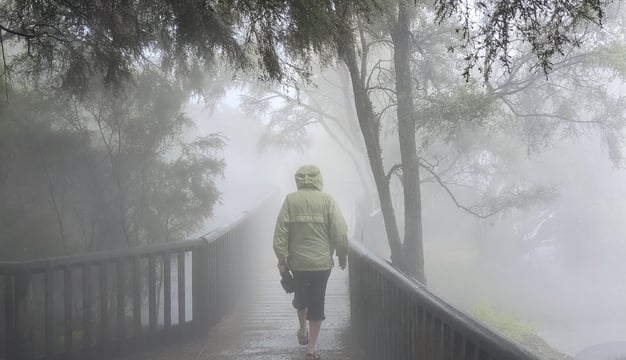

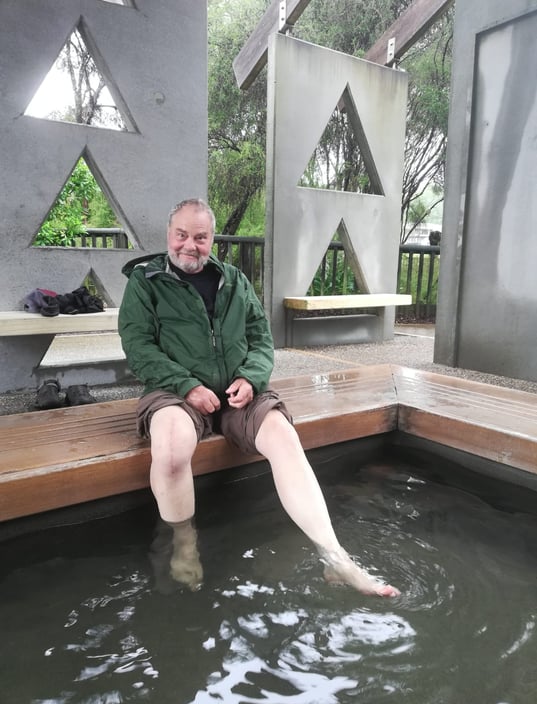

Footnotes:
1) Because the Sequouias grow so fast in New Zealand, their growth rings in the trunk are much much wider than you'd see on a California speciman. So much so that the wood here is considered a soft wood, while in the States Redwood is a pretty renowned hardwood!
2) One of the most amazing facts we learned about kiwis: they have largest egg to body ratio of any bird on earth! Despite the adult female being slightly smaller than a chicken, their eggs are larger than a softball and can weigh up to 1/4th of the female's bodyweight. Apparently this would be the equivalent to a human giving birth to a 6 year old child!
3) New Zealand was the first country in the modern world to grant women the right to vote in 1893, among other progressive policies. Today, they have the youngest female prime minister, Jacinda Ardern, although she sadly just announced she will be stepping down early this year.
But, it wasn't the redwoods or even the geothermals that had got Rotorua on our itinerary, but for a more cultural attaction. Rotorua is the heart of Te Puia’s Whakarewarewa Valley, home to a living Maori village and the New Zealand Maori Arts and Crafts Institute, with traditional wood carving and weaving schools. In addition to seeing amazing carved wood statuary and gates throughout town, we also paid for full Maori dinner and cultural show. I hope to write a more extensive most on the Maori later, but a few short thoughts on the Maori here. First, the experience of Maori when Europeans arrived shares some similarities to Native Americans in some ways, with issues of disease, land stolen, and misunderstandings. But the Maori have managed to stay better off in terms of presence and rights than most Native Americans for a variety of reasons. Second, the Maori themselves are relatively recent arrivals to New Zealand in the scheme of history, likely first arriving sometime between 1200 and 1400CE. Much of their cultural mythos speaks about how their ancestors sailed across the sea from Hawaiki, likely somewhere in East Polynesia or maybe even Hawaii, making the similarity in nomenclature not coincidental. The similarities to Polynesian culture was quite evident. In fact, the dinner, a mix of meats, tubers and veg cooked over many hours in a ground pit, shared many similarities to the luau's many Americans get to experience when visiting Hawaii. Our Maouri hosts also treated us to a wonderful dance performance and answered many questions about their historic culture and current practices. It made for an enjoyable and educational evening.
Mom is walking on a boardwalk not through mist but steam coming off a geothermally heated pond! Dad enjoys the free geothermally heated footbath.
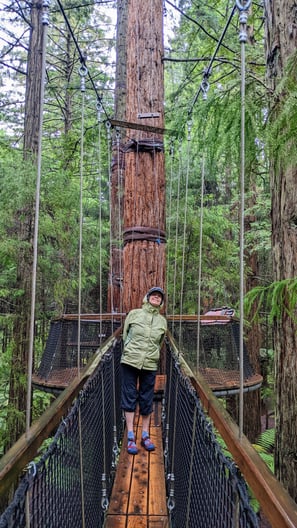

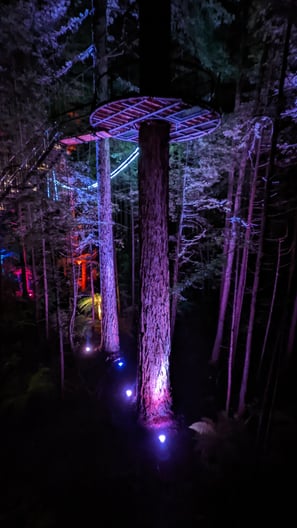

Redwood canopy walk on rainy day.
Redwood canopy walk lit at night.
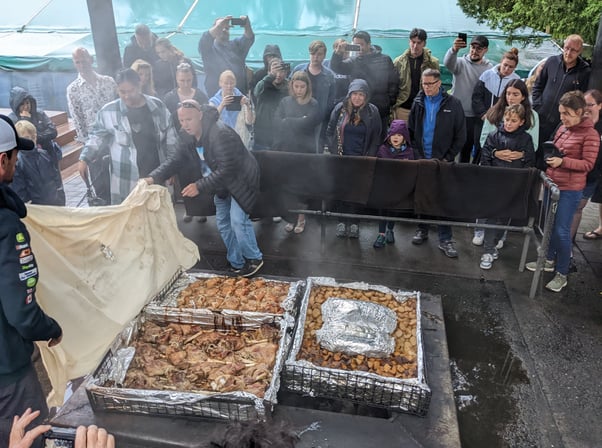

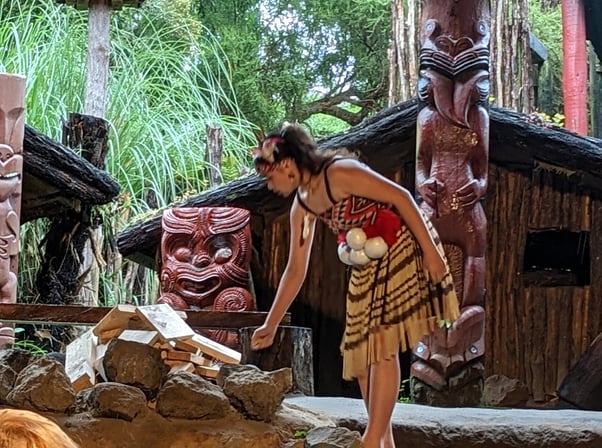

The Maori-served dinner came from a more modern version of a pit in the ground.
We had one other memorable experience in Rotorua: a kiwi experience! Not kiwi the fruit (although they are extra good in New Zealand) and not kiwi the people (New Zealanders do call themselves kiwis) but kiwi the uber cute bird! Kiwis, the namesake behind all the other kiwis, are native to New Zealand and are also endangered largely due to predation by invasive mammalian predators while in their eggs or as chicks. We visited the Te Puia Kiwi Conservation Centre, where they are working to help save the kiwi by literally stilling kiwi's eggs in the wild, incubating and raising them until they are large enough to put them out of danger of most of those unnatural predators. We got to see the kiwis eggs2, a baby kiwi being weighed, and adolescent kiwis in captive habitat. They are quite cute have whiskers like a cat! No photos allowed though, as accidental flash photography can hurt their little nocturnal eyes.
The next day, we hit the road again, heading for New Zealand's largest city, Auckland. Blessed with a final couple days of sun before my parents departure, we rushed about town, taking a lovely ferry ride across the harbor (technically Oneoneroa in Maori or Shoal Bay) to the northern suburb town of Devonport. A short hike up Mount Victoria granted beautiful views back over the city before heading to dinner along the shore. The next day we took a free walking tour with a very veteran tour guide, and learned a bit more about New Zealand's colonial and progressive history3, meat pies, and current political structure. We followed this up with a nice walk through the somewhat lackluster (compared to others we'd seen) botanic gardens, before dropping my folks off at the airport for their long journey home.
